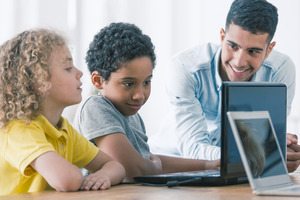Adapting to New Educational Norms: Online Learning for Kids
Hey there! So, you’re thinking about online learning for your kids, huh? Well, buckle up because we’re diving into a world that’s as exciting as it is daunting. I know, I know—it sounds like a lot to take in. But don’t worry, I’m here to break it down for you in simple English. Let’s get started!
The Rise of Online Learning
Remember when school was all about sitting in classrooms, staring at blackboards, and passing notes under the desk? Yeah, those were the days. But now, thanks to technology, learning isn’t just confined to a physical classroom. With the internet, kids can access lessons, educational games, and even entire curriculums right from their living rooms. Pretty wild, huh?
Why Online Learning?
So, why should you consider online learning for your kids? For starters, it’s incredibly flexible. Whether your kid is an early bird or a night owl, they can learn at their own pace and on their own schedule. No more rushing out the door in the morning or dragging them out of bed for those dreaded early classes. Plus, it’s perfect for families who travel a lot or have unpredictable schedules.
For older kids, online learning can be a game-changer, especially when it comes to more advanced subjects. Did you know that some platforms even offer access to online GCSEs? Yep, they can study and take exams right from home. This can be particularly useful for kids who need a more flexible schedule or those who are pursuing other interests alongside their studies.
A Personalized Approach
One of the coolest things about online learning is how personalized it can be. Ever noticed how kids learn in different ways? Some are visual learners, others need to hear things out loud, and some just have to get hands-on. Online platforms can cater to all these learning styles. With videos, interactive quizzes, and virtual labs, there’s something for everyone. It’s like having a tailor-made education plan just for your kid!
Here are the different types of learning and how online platforms cater to each:
Visual Learners
These kids learn best through seeing. They love diagrams, charts, videos, and visual aids. Online learning platforms often have a wealth of video tutorials, colorful infographics, and interactive maps that make information pop.
Auditory Learners
For those who absorb information better by listening, online learning offers audio recordings, podcasts, and read-aloud features. These tools help them grasp concepts by hearing explanations and stories.
Kinesthetic Learners
These hands-on learners need to move and do to understand. Online learning can include interactive simulations, virtual labs, and practical exercises that let them experiment and learn by doing.
Reading/Writing Learners
Some kids prefer to read texts and write notes. Online platforms provide eBooks, articles, and writing assignments that cater to this learning style. They can read at their own pace and take notes in a way that helps them best.
Logical/Mathematical Learners
These students thrive on problem-solving and logical thinking. Online math games, coding challenges, and puzzle-based learning tools can engage their analytical minds.
Social Learners
Kids who learn best in groups can benefit from online forums, group projects, and virtual classrooms where they can collaborate and discuss with their peers.
Solitary Learners
Some children prefer to study alone. Online learning allows them to work independently, set their own pace, and focus without the distractions of a traditional classroom.
By recognizing and catering to these different learning styles, online education can create a more engaging and effective learning experience for every child.
The Wide World of Resources
Now, let’s talk resources. The internet is a treasure trove of educational content. From videos on how volcanoes erupt to interactive games that teach math, there’s no shortage of learning materials. And guess what? Many of these resources are free. Yep, you heard me right—free! Of course, there are paid options too, but the point is, there’s a wealth of knowledge at your fingertips.
Social Interaction—Online Style
“But what about social interaction?” I hear you ask. Good question! While it’s true that online learning doesn’t offer the same face-to-face interactions as traditional schools, it’s not completely devoid of social elements.
Many online programs include discussion forums, group projects, and even virtual classrooms where kids can interact with their peers. It’s a different kind of socializing, sure, but it’s socializing nonetheless.
- Discussion forums
- Group projects
- Virtual classrooms
Developing Independence
Here’s another perk: online learning can help kids develop a sense of independence. Without a teacher physically present to guide them every step of the way, they learn to take charge of their education. They figure out how to manage their time, set goals, and stay motivated. These are valuable life skills that’ll serve them well beyond their school years.
The Challenges
Of course, it’s not all sunshine and rainbows. Online learning does come with its own set of challenges. For one, it requires a certain level of self-discipline. Without the structure of a traditional classroom, some kids might struggle to stay focused.
And let’s not forget the potential for technical issues. A slow internet connection or a glitchy platform can quickly turn a productive day into a frustrating one.
Parental Involvement
This brings us to an important point: parental involvement. Online learning doesn’t mean you can just set it and forget it. Especially for younger kids, parents need to play an active role in their education. This might mean helping them log in to their classes, staying nearby to keep them on task, or even learning the material alongside them. It’s a team effort, no doubt about it.
Choosing the Right Program
With so many options out there, how do you choose the right online learning program for your kid? Start by considering their learning style and interests. Are they more into science and math, or do they have a passion for the arts? Look for programs that align with their strengths and interests. And don’t be afraid to try out a few different ones until you find the right fit.
- Learning Style Compatibility: Does the program cater your child’s preferred learning style?
- Curriculum Quality: Check if the curriculum is comprehensive and aligns with your educational goals and standards.
- Interactivity and Engagement: Look for programs with interactive elements like quizzes, games, and virtual labs to keep your child engaged.
- Flexibility: Consider if the program offers flexible scheduling to fit your family’s routine and your child’s pace.
- Support and Resources: Evaluate the availability of teacher support, tutoring, and additional learning resources.
- Technology Requirements: Make sure your home tech setup meets the program’s requirements for a smooth learning experience.
- Cost and Value: Compare the cost of the program with the value of the education and resources provided, including free options.
- Reviews and Reputation: Read reviews and ask for recommendations to ensure the program has a good track record and positive feedback from other parents and students.
Online Safety
We can’t talk about online learning without addressing safety. The internet is a fantastic resource, but it also has its risks. Make sure you’re using reputable platforms and keep an eye on your kid’s online activity. Teach them about online privacy and the importance of not sharing personal information. It’s all about creating a safe and productive learning environment.
The Future of Learning
So, what does the future hold for online learning? If the past few years are any indication, it’s only going to get bigger and better. With advances in technology, we’re seeing more immersive and interactive learning experiences. Think virtual reality classrooms and AI tutors. It’s an exciting time to be a learner!
Wrapping It Up
To make the most of online learning, it’s important to stay involved and stay flexible. Be open to trying new things and don’t be afraid to switch things up if something’s not working. Remember, the goal is to create a learning experience that’s both effective and enjoyable for your kid.
With a bit of patience and a lot of curiosity, online learning can be a fantastic way for your kid to learn and grow. Whether you’re looking for a flexible schedule, a personalized approach, or access to unique resources, online learning has something to offer. So why not give it a shot? You never know, it might just be the perfect fit for your family.







